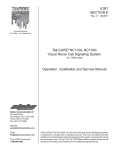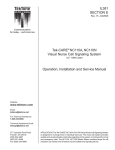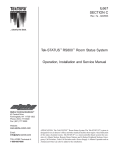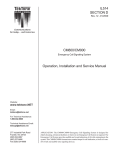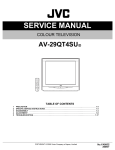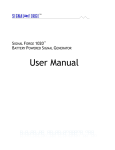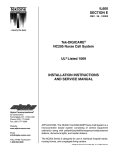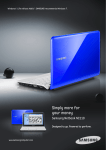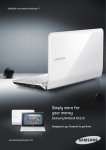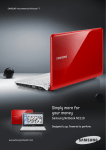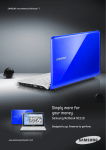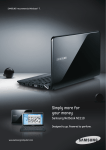Download Tek-CARE® NC110 Visual Nurse Call Signaling
Transcript
IL381 SECTION E Rev. 19 - 07/2014 Tek-CARE® NC110 Visual Nurse Call Signaling System UL® 1069 Listed Operation, Installation and Service Manual www.tektone.com Phone: (828) 524-9967 Toll-Free: (800) 327-8466 Sales: Option 2 Tech Support: Option 3 277 Industrial Park Road Franklin, NC 28734 [email protected] Fax: (828) 524-9968 The Tek-CARE® NC110 Visual Nurse Call Signaling System is designed for nursing home or individual ward use. The nurse call system provides audible and visual indication of all calls originating in the system, including both normal and emergency calls. The NC110A and NC110N Master Stations contain lamps for call indication, as well as tone-off switch and an audible tone signaling device. Operation, Installation and Service Manual Copyright © 2001–2014 TekTone® Sound & Signal Mfg., Inc., All rights reserved. No part of this publication may be copied without the express written permission of TekTone® Sound & Signal Mfg., Inc. The content of this manual is furnished for informational use only, is subject to change without notice, and should not be construed as a commitment by TekTone® Sound & Signal Mfg., Inc. TekTone® Sound & Signal Mfg., Inc. assumes no responsibility or liability for any errors or inaccuracies that may appear in this documentation. TekTone, the TekTone logo, Tek-Alert, Tek-Bridge, Tek-Call, Tek-Care, Tek-Check-In, Tek-Com, Tek-Entry, Tek-Guard, Tek-Micro, Tek-MMARS, Tek-Paging, Tek-Safe and Tek-Status are either registered trademarks or trademarks of TekTone® Sound & Signal Mfg., Inc. in the United States and/or other countries. All other trademarks are the property of their respective owners. TekTone® Sound & Signal Mfg., Inc., 277 Industrial Park Road, Franklin, North Carolina 28734, USA. ii • IL381 Tek-CARE® NC110 Manual Copyright © TekTone Sound & Signal Mfg., Inc. All Rights Reserved. Table of Contents System Operating Instructions���������������������������������� 1 NC110N Master Stations���������������������������������������������� NC110A Master Stations���������������������������������������������� SF100C, SF102, SF100N, SF100/2 Call Stations��������������������������� SF101C, SF101N Call Stations������������������������������������������ SF155B, SF339, SF151N, SF153N Emergency Stations and SF156B Code Station�� LI150B, LI150N Duty Stations����������������������������������������� LI382LED Corridor/Zone Lights, LI381 Corridor Lights�������������������� LI382LED Corridor/Zone Lights, LI382 Zone Lights����������������������� 1 3 3 3 4 5 5 5 PK152, PK151A Power & Control Units���������������������������������� PK800A Secondary Power Supply�������������������������������������� NC110N Master Stations���������������������������������������������� NC110A Master Stations���������������������������������������������� SF100C, SF100N, SF100/2, SF101B, SF101C, SF101N, SF102 Call Stations���� SF155B, SF339, SF151N, SF153N Emergency Stations and SF156B Code Station�� 6 6 6 7 7 7 System Operating Principle������������������������������������� 6 System Installation��������������������������������������������� 8 Installation Procedure������������������������������������������������ 8 Equipment Locations������������������������������������������������� 8 Wiring Installation��������������������������������������������������� 9 Station Wiring Layout������������������������������������������������ 9 Housing Installation������������������������������������������������� 10 Wire Checkout����������������������������������������������������� 11 Wire Connections��������������������������������������������������� 12 Connections Checkout����������������������������������������������� 12 System Test Instructions��������������������������������������������� 12 System Checkout and Testing����������������������������������������� 13 System Maintenance Instructions������������������������������� 14 NC110A Master Stations��������������������������������������������� NC110N Master Stations��������������������������������������������� PK152, PK151A Power & Control Units��������������������������������� PK153 Third Priority Control Unit������������������������������������� PK800A Secondary Power Supply������������������������������������� 4A Fast-Blow Fuse Assembly����������������������������������������� SF100C, SF100N, SF100/2, SF102 Call Stations�������������������������� SF101C, SF101N Call Stations����������������������������������������� SF155B, SF339, SF151N, SF153N Emergency Stations and SF156B Code Station� LI150B, LI150N Duty Stations���������������������������������������� LI381 Corridor and LI382 Zone Lights��������������������������������� Replacement Parts�������������������������������������������������� Copyright © TekTone Sound & Signal Mfg., Inc. All Rights Reserved. 14 14 15 15 15 15 16 16 16 16 16 16 IL381 Tek-CARE® NC110 Manual • iii Table of Contents Illustrations Figure 1—NC110N Master Station Control Locations���������������������� 1 Figure 2—NC110A Master Station Control Locations���������������������� 2 Figure 3—Call Station and Call Cord Control Locations�������������������� 2 Figure 4—Emergency, Code, Call & Duty Station Control Locations���������� 4 Figure 5—Master Panel Housing Chart and Wall Cut-Out Details����������� 10 Figure 6—Ring & Back Box for Call, Emergency, Code & Duty Stations, and Corridor & Zone Lights����������������������������������� 10 Figure 7—SS106 Transformer Installation������������������������������ 10 Figure 8—NC110N Selector Lamp/Switch Lens, Filter and Lamp Replacement�� 14 Figure 9—Block Wiring Diagram without Zone Lamps�������������������� 17 Figure 10—Block Wiring Diagram with Zone Lamps��������������������� 18 Figure 11—NC110A Wiring Diagram���������������������������������� 19 Figure 12—NC110N Wiring Diagram���������������������������������� 20 Figure 13—NC150N, NC200N, Two Stations in Parallel������������������� 21 Figure 14—NC110A Housing Installation Diagram����������������������� 22 Figure 15—PL116 Wall Plate Wiring Diagram��������������������������� 22 Figure 16—NC110N Second Master Wiring Diagram��������������������� 23 Figure 17—PK153 Wiring Diagram������������������������������������ 24 Figure 18—PK153 Wiring Diagram with SF156B Code Station������������� 25 Figure 19—PK152 or PK151A to PK800A Interconnection���������������� 26 Figure 20—SF337C Cross Reference Diagram��������������������������� 27 Figure 21—SF339 Cross Reference Diagram���������������������������� 28 Figure 22—NC110N Hookup to NC150N, NC200N����������������������� 29 Figure 23—SF157 and SF157/2 Wiring Diagram������������������������ 30 iv • IL381 Tek-CARE® NC110 Manual Copyright © TekTone Sound & Signal Mfg., Inc. All Rights Reserved. System Operating Instructions NC110N Master Stations This section provides complete operating instruction for all Tek-CARE® NC110 functions, as well as reference drawings for use in locating and describing all controls. System operators must read the following operating instructions concerning system equipment and the terms used in conjunction with the equipment. Refer to Figure 1 for locations, names, and functions of controls and indicators. Answer Emergency Calls: All emergency calls take precedence over any normal call signal. Calls must be answered in person and can only be canceled from point of origin. Emergency calls are indicated by simultaneous operation of the following signals: • Rapid flashing of the associated station selector lamp, which is marked to indicate origin of call. • Rapid flashing of call lamp and emergency lamp. • Rapidly pulsing audible tone. Answer Normal Calls: Calls must be answered in person and can only be canceled from point of origin. Normal calls are indicated by simultaneous operation of the following signals: • Steady illumination of the associated station selector lamp which is marked to indicate origin of call. • Steady illumination of call lamp. • Slowly pulsing audible tone. The audible call signal may be canceled for normal calls by pressing the tone off button. The tone off button will then illuminate to indicate tone silenced. Pressing the tone off button when illuminated will reset the call tone. Figure 1—NC110N Master Station Control Locations 1 – Tone Off Button: Silences normal call tone when depressed. – Tone Off Lamp: Indicates tone silenced when illuminated. 2 – Tone Test Button: Activates tone signal when depressed. 3 – Call Lamp: Indicates incoming call when illuminated. Indicates emergency call when flashing. 4 – Emergency Lamp: Indicates emergency call when flashing. 5 – Station Selector Lamps (PM110/4N): Indicates incoming call from associated remote when illuminated. Indicates emergency call from remote when flashing. 6 – Lamp Test Button: Illuminates all lamps on panel when pressed. Copyright © TekTone Sound & Signal Mfg., Inc. All Rights Reserved. Drawing Name & Number: IL381 NC110N Product Rev0 121902 1 IL381 Tek-CARE® NC110 Manual • 1 Figure 2—NC110A Master Station Control Locations CALL INDICATOR CALL EMERGENCY CALL INDICATOR EMER. ROUTINE TONE OFF TONE OFF TONE VOLUME SELECTOR VOLUME TONE TEST CALL TONE TEST SYSTEM POWER INDICATOR ROOM INDICATORS POWER Figure 3—Call Station and Call Cord Control Locations SF100C Call Station SF102 Dual Call Station SF301A Call Cord SF302 Call Cord 4 IL381 SF102 Product Rev0 121902 1 5 IL381 SF100C Product Rev0 121902 1 1 –Call Placed Lamp: Indicates a call is placed when flashing. 2 – Cancel Button: Cancels the call when pressed. SF100N Call Station SF100/2 Dual Call Station 3 –Call Cord Jack: Receptacle for SF301A or SF302 call cord. 4 –Plug: Connects call cord to patient station when plugged into call cord jack. 5 – Call Button: Places a call when pressed, if cord is connected to patient station. 2 • IL381 Tek-CARE® NC110 Manual Copyright © TekTone Sound & Signal Mfg., Inc. All Rights Reserved. System Operating Instructions Test Tone Signal: Press the tone test button. A tone signal should be heard at the master station. Test Station Selector Lamps: Press the lamp test button (one is included for each panel of annunciator lamps). All annunciator lamps on that panel should be illuminated. (See System Maintenance Instructions for proper procedures and precautions in replacing defective lamps.) Improper Operation: • If the NC110N Master Station fails to operate as described, contact qualified service personnel. There are no user replaceable parts on the NC110N Master Station other than the station selector lamps and lenses. • If a malfunction occurs during a call and causes a lack of indication of call origin on the master station, first determine the origin of the call by observing which corridor light and corridor zone light is illuminated, then inform qualified service personnel. NC110A Master Stations Refer to Figure 2 for locations, names, and functions of controls and indicators. Operation of the NC110A is similar to that of the NC110N, except that there is no selector lamp test (NC110A has selector LEDs instead). Adjust volume: The NC110A master station has three volume levels. Press the volume button until the desired level is reached. The level is indicated by three lighted LEDs above the volume button. Use the tone test button to test volume when adjusting the volume. Selector point labeling: A slot is provided at the top of each column of selector points for inserting a paper strip (TekTone® part number LB516). Apply room-identifying labels between the dashed lines so that each label lines up with the intended selector point on the NC110A membrane switch. SF100C, SF102, SF100N, SF100/2 Call Stations Refer to Figure 3 for locations, names, and functions of controls and indicators. Call a Nurse: Press the call button located on the end of the call cord. The call placed lamp will illuminate to indicate call placement. Wait for the nurse. Refer to Figure 3 for locations, names, and functions of call cord controls. Cancel a Call: Press the cancel button. Indicator will go off. If the call cord is pulled from its receptacle, a call will be placed automatically and cannot be canceled until the call cord is replaced in the receptacle. Replace Call Cord: See System Maintenance Instructions for proper procedures and precautions in replacing defective call cords. Improper Operation: If the call station does not operate as described, contact qualified service personnel. There are no user serviceable parts on the SF100C, SF102, SF100N and SF100/2 Call Stations other than cords. SF101C, SF101N Call Stations Refer to Figure 4 for locations, names, and functions of controls and indicators. Call a Nurse: Press the call button. The call placed lamp will illuminate to indicate call placement. Wait for the nurse. Copyright © TekTone Sound & Signal Mfg., Inc. All Rights Reserved. IL381 Tek-CARE® NC110 Manual • 3 System Operating Instructions Cancel a Call: Press cancel button. Indicator will turn off. Improper Operation: If the call station does not operate as described, contact qualified service personnel. There are no user serviceable parts on the SF101C and SF101N Call Stations. SF155B, SF339, SF151N, SF153N Emergency Stations and SF156B Code Station Refer to Figure 4 for locations, names, and functions of controls and indicators. Call a Nurse: Pull the call cord, slide the call/cancel switch down, or press the call/cancel button. The call placed lamp will flash. Wait for the nurse. Cancel a Call: Push the call/cancel switch up, press the call/cancel button, or twist the push button. The call placed lamp will go off. Figure 4—Emergency, Code, Call & Duty Station Control Locations SF155B Emergency Station SF339 Emergency Station SF101C Call Station SF156B Code Station LI150B Duty Station Tone Off IL381 SF101C Product Rev0 121902 1 SF151N Emergency Station SF153N Emergency Station SF101N Call Station IL381 LI150B Product Rev0 122002 1 LI150N Duty Station IL381 LI150N Product Rev0 122002 1 1 – Call Placed Lamp: Indicates a call is placed when flashing. 2 – Cancel Button: Cancels the call when pressed. 3 – Call Button: Places a call when pressed. 4 – Call/Cancel Switch: Places a call when pulled down. Cancels the call when pushed up. 5 – Call Cord: Places a call when pulled. 6 – Call/Cancel Button: Places a call when pressed to in position. Cancels the call when pressed or twisted to out position. 7 – Tone Off Switch: Silences normal audible tone signal when pushed down. 4 • IL381 Tek-CARE® NC110 Manual Copyright © TekTone Sound & Signal Mfg., Inc. All Rights Reserved. System Operating Instructions LI150B, LI150N Duty Stations Improper Operation: If the call station does not operate as described, contact qualified service personnel. There are no user serviceable parts on the SF155B, SF339, SF151N, SF153N Emergency Stations or the SF156B Code Station. Refer to Figure 4 for locations, names, and functions of controls and indicators. Emergency Calls: Emergency calls are indicated by a flashing call placed lamp and a rapidly pulsing audible tone. The audible tone signal cannot be silenced by the tone off switch. Normal Calls: Normal calls are indicated by steady illumination of the call placed lamp and a slowly pulsing audible tone. Push the tone off switch down to silence the audible tone signal. Push the tone off switch up to turn the audible tone signal on. Improper Operation: If the call station does not operate as described, contact qualified service personnel. There are no user serviceable parts on the LI150B and LI150N Duty Stations. LI382LED Corridor/Zone Lights, LI381 Corridor Lights Emergency Calls: Emergency calls are indicated by rapid flashing of the corridor light that is associated with the calling station. Normal Calls: Normal calls are indicated by steady illumination of the corridor light that is associated with the calling station. Lamp Replacement: See System Maintenance Instructions for proper procedures and precautions in replacing defective LI381 lamps. Improper Operation: If corridor light does not operate as described, contact qualified service personnel. There are no user serviceable parts on the LI382LED Corridor/Zone Lights. There are no user serviceable parts on the LI381 Corridor Lights other than lamps. LI382LED Corridor/Zone Lights, LI382 Zone Lights The LI382 Zone Light includes two indicator lamps: a clear normal call indicator lamp and an emergency call indicator lamp with a red bulb cover. The LI382LED Corridor/Zone Light includes four indicator LEDs: two clear normal call indicator LEDs that operate in unison, and two red emergency call indicator LEDs that operate in unison. Emergency Calls: Emergency calls are indicated by rapid flashing of the red corridor zone light(s) associated with the zone or area from which an emergency call has been placed. Normal Calls: Normal calls are indicated by steady illumination of the white corridor zone light(s) associated with the zone or area from which a normal call has been placed. Concurrent Emergency and Normal Calls: If an emergency and normal call are placed in the same zone at the same time, the red light(s) connected to the emergency station from which a call was placed will flash rapidly, while the white light(s) associated with the normal call will maintain a steady illumination. Lamp Replacement: See System Maintenance Instructions for proper procedures and precautions in replacing defective LI382 lamps. Improper Operation: If corridor zone light does not operate as described, contact qualified service personnel. There are no user serviceable parts on the LI382LED Corridor/ Zone Lights. There are no user serviceable parts on the LI382 Corridor Zone Lights other than lamps and red bulb cover. Copyright © TekTone Sound & Signal Mfg., Inc. All Rights Reserved. IL381 Tek-CARE® NC110 Manual • 5 System Operating Principle Each system uses a series of bus conductors to carry the operating and signaling voltage to the various units. In addition, each station capable of calling the master station has individual conductors between it and the master to give the station its own identity. When a call button is depressed, switching circuits operate to light various call lights and to energize system call tone. All calls must be reset at the point of origin. Emergency calls are signaled by a different flashing rate at the master station. An emergency call is indicated by an intermittent tone and flashing lights at approximately 1/3-second intervals. A normal call is indicated by a steady lamp and an intermittent tone at approximately 8-second intervals. The Tek-CARE® NC110 Nurse Call System includes three basic units, each essential for operation. These will be discussed individually and are as follows: • Power & Control Unit • Master Station • Call Stations The use of these basic units, in conjunction with wiring, housings and auxiliary equipment, make up a complete system. PK152, PK151A Power & Control Units The power & control unit utilizes a transformer which steps down the 120 VAC input to 24 VAC, 30 VA, which is then rectified, filtered and regulated to provide a stable 24 VDC for the rest of the system. Control circuits are provided to detect the presence of normal or emergency calls and to provide steady or intermittent voltages to operate external devices with indications as follows: Normal calls are indicated by a positive voltage applied to Terminal R by the calling remote station. Emergency calls are indicated by a positive voltage applied to terminal Q by the calling remote station. PK800A Secondary Power Supply NC110N Master Stations The secondary power supply accepts a 24 VAC input from the SS100 transformer. It rectifies, filters and regulates a +24 VDC output, which is provided on the two terminals labeled “24 VDC.” A +5 VDC output is also available, but is not used in this application. The Master Station includes: • Buzzer for audible signals. • Annunciator lamps for call indication. • Additional operating controls, including tone off and tone test switches and additional emergency and normal call indicators. 6 • IL381 Tek-CARE® NC110 Manual Copyright © TekTone Sound & Signal Mfg., Inc. All Rights Reserved. System Operating Principle NC110A Master Stations The NC110A’s design is based on the NC110N master station. The NC110N’s control switches have been replaced with relays that have reliable control circuitry, which are operated via the buttons on the NC110A membrane switch. The NC110A uses an electronic oscillator circuit to generate call tones via an enclosed 45-ohm speaker. A simple digital counter keeps track of tone volume and is advanced by pressing the volume button. The NC110A includes an isolated N/O relay contact for ancillary off-board call handling. An RC hold circuit keeps the contact closed during off cycles of the call indication LED. For this reason, the contact will remain closed for a few seconds after call activity at the station has ended. SF100C, SF100N, SF100/2, SF101B, SF101C, SF101N, SF102 Call Stations The SF100C, SF100N, SF100/2, SF101C and SF102 Call Stations are for normal calls that use an LED visual indicator. Pressing the momentary call button initiates a routine level call. A latching circuit maintains signaling after the call button has been released. Pressing the cancel button cancels the call. Call stations SF101B and SF101N have different features, but function in a similar manner. SF155B, SF339, SF151N, SF153N Emergency Stations and SF156B Code Station The SF155B Emergency Station is for emergency calls. In the emergency position, associated signal lights are disconnected from the normal signal terminals and connected to the emergency signal terminals. Emergency stations SF339, SF151N and SF153N, and code station SF156B have different features, but function in a similar manner. Copyright © TekTone Sound & Signal Mfg., Inc. All Rights Reserved. IL381 Tek-CARE® NC110 Manual • 7 System Installation Installation Procedure Step 1: Read the following instructions concerning system equipment and determine installation methods before proceeding. Step 2: Determine equipment location. Step 3: Install wiring. Step 4: Install housing. Step 5: Check wires. Step 6: Connect equipment. Equipment Locations Step 7: Check connections. NC110A, NC110N Master Stations: Locate master stations within easy reach of operating personnel. Do not exceed operating temperature of 10° C–30° C. SF100C, SF101C, SF102 Call Stations: Locate call stations where convenient for operation. Calls are placed on the SF100C and SF102 by means of a call cord, permitting easy operation by seated or prone patients. Calls are placed on the SF101C by means of a push button located on the station. SF155B, SF339 Emergency Stations and SF156B Code Station: Locate emergency stations where convenient for operation. Avoid areas where direct contact with water may occur. The SF155B includes a 6’ long pull cord permitting installation high enough to provide easy operation by the nurse and by seated or prone patients. The SF155B may be used without the cord as a pull down actuated switch. LI150B Duty Stations: Locate duty stations as needed and where convenient for operation. Location should provide for unobstructed visibility of the call indicator. LI382LED, LI381 Corridor Lights: Locate corridor lights in the corridor above or beside the door of the associated room. Location should provide for unobstructed visibility of the corridor light in both directions. LI382LED, LI382 Zone Lights: Locate zone lights in the corridor area nearest the nurses central monitoring station. Location should provide for unobstructed visibility of each zone light from the central location. SF301-series, SF302-series Call Cords: Insert call cord plugs into associated station jacks as indicated on the stations. PK152, PK151A Power & Control Units: Locate the PK152 or PK151A and the IH151N junction box in an accessible area. Do not exceed operating temperature range of 10° C–30° C. Location should provide for convenient cable runs to remote and master stations. Cable run from the PK152 or PK151A to the NC110N Master Station must not exceed 100’. PK153 Third Priority Conrol Unit: Locate the PK153 in the same location as the PK152 or PK151A Power & Control Unit. 8 • IL381 Tek-CARE® NC110 Manual Copyright © TekTone Sound & Signal Mfg., Inc. All Rights Reserved. System Installation PK800A Secondary Power Supply: Locate the PK800A in an accessible area within 2 feet of the PK152 or PK151A that it is to be connected to. Do not exceed operating temperature range of 10°C–30°C. The PK800A is for use in applications that exceed the current load capacity of the PK152 or PK151A (1 amp). The PK800A allows the current load to be increased to 3 amps. The 4A fast-blow fuse assembly (included with the PK800A) must be located between the PK800A and the PK152 or PK151A. See Figure 19 for actual FZ151 connection points. Wiring Installation 24 VAC 100 VA Transformer: For use with the PK800A. Locate the transformer within 3 feet of the PK800A Secondary Power Supply. Do not exceed operating temperature range of 10°C–30°C. Run wiring conduit from corridor light to corridor light and terminate at the PK152 or PK151A Power & Control Unit. Limit each run to 15 corridor lights and 600 feet of wire. Select conduit size to accommodate the following cables: • 3 cond. #18 common to all call stations (except LI150B Duty Stations). Add 2 cond. #18 common if LI382 Zone Lights are used. • Run 3 cond. #18 common from LI382 to PK152 or PK151A Power & Control Unit. • 1 cond. #22 selective for each SF155B Emergency Station not used in conjunction with a call station. Station Wiring Layout • 4 cond. #22 to one LI150B Duty Station. Use 4 cond. #18 if feeding more than one duty station. Install a maximum of 4 duty stations per system. If more are needed, call factory for wiring information. NC110A, NC110N Master Stations: Run cable or conduit directly from the master station to the PK152 or PK151A Power & Control Unit and the IH151N Junction Box. Include the following: • 5 cond. #18 • 1 cond. #22 for each SF100C/SF101C/SF102 Call Station. • 1 cond. #22 for each SF155B Emergency Station not used in conjunction with a call station. SF100C, SF101C, SF102 Call Stations: Run 4 cond. #22 directly to associated SF155B Emergency Station. If an emergency station is not used, run cable directly to the associated corridor light. If more than one call station is used in the same room, all stations run directly to the emergency station (if used). SF155B Emergency Stations: Run 4 cond. #22 for each call station associated with the SF155B. Run cable directly to associated corridor light. If no call station is used, only 3 cond. #22 is needed from the SF155B to the corridor light. LI150B Duty Stations: Run 4 cond. #22 to the PK152 or PK151A Power & Control Unit. Use 4 cond. #18 if feeding more than one duty station. Install a maximum of 4 duty stations per system. If more are needed, call factory for wiring information. Power Wiring: Run conduit and 2 cond. #18 cable from the PK152 or PK151A Power & Control Unit and the IH151N Junction Box to 117 VAC - 60 cycle power source. Do not connect power. Refer to Figure 11 and Figure 12 for typical system wiring and cable sizes. Copyright © TekTone Sound & Signal Mfg., Inc. All Rights Reserved. IL381 Tek-CARE® NC110 Manual • 9 System Installation Housing Installation NC110A Master Station: The NC110A is a desktop unit. Locate the PL116 wall plate directly behind the desk to accommodate the NC110A. Mount the wall plate to a four-gang electrical backbox with a three-gang mud ring (TekTone® part numbers IH353 and IH352 respectively). Connect the NC110A to the wall plate using the provided 8-wire, RJ-terminated cable (CA045) and fixed 50-wire ribbon cable (CA046). Gather extra length in the ribbon cable and tie as shown. See Figure 14 for unit placement. NC110N Master Station: Flush Wall Mounting: Provide wall cutout as shown in Figure 5. Fit back box and frame assembly into prepared opening. Fasten assembly in place using screws. Back box must be TekTone® OH200-series. Surface Wall Mounting: Fasten box and frame assembly to wall through holes provided in back of box. Use suitable fasteners. Back box must be TekTone® OH300-series. Figure 5—Master Panel Housing Chart and Wall Cut-Out Details 4″ min. Finished Wall 16″ 16.25″ B 3.75″ B 16.25″ B 66″ In masonry walls, install 0.5″×4″ wood fillers at top and bottom of opening for housing attachment. Finished Floor Figure 6—Ring & Back Box for Call, Emergency, Code & Duty Stations, and Corridor & Zone Lights Housing Wall Opening Flush Surface Width (B) Height OH202 OH302 8.5″ 16.25″ OH203 OH303 12.5″ 16.25″ OH204 OH304 16.5″ 16.25″ OH205 OH305 20.5″ 16.25″ Figure 7—SS106 Transformer Installation Install ring with panel mounting holes at top and bottom, as shown. 10 • IL381 Tek-CARE® NC110 Manual Copyright © TekTone Sound & Signal Mfg., Inc. All Rights Reserved. System Installation SF100C, SF101C, SF102 Call Stations, SF155B Emergency Station: Install single gang ring (or single gang ring and double gang box) as shown in Figure 6 for each call and emergency station in the system. Ring and back box must be UL® approved. Minimum dimensions of back box must be not less than 4″×4″×1.5″. Minimum opening on ring must be not less than 1.75″×2.75″. Minimum clearance from live parts on station to dead metal parts must be not less than 0.5″. LI150B Duty Stations: Install single gang ring (or single gang ring and double gang box) as shown in Figure 6 for each duty station. Ring and back box must be UL® approved. Minimum dimensions are the same as for the call/emergency stations listed previously. LI382LED Corridor/Zone Lights: Install standard one- or two-gang box with one- or two-gang ring as shown in Figure 6 for each corridor light in system. Ring and back box must be UL® approved. Minimum clearance from live parts of station to dead metal parts to be not less than 0.5″. LI381 Corridor Lights, LI382 Zone Lights: Install double gang ring (or double gang ring and double gang box) as shown in Figure 6 for each corridor light in system. Ring and back box must be UL® approved. Minimum dimensions of back box must be not less than 4″×4″×1.5″. Minimum opening of ring must be not less than 2.75″×2.75″. Minimum clearance from live parts of station to dead metal parts must be not less than 0.5″. PK152 or PK151A Power & Control Unit, IH151N Junction Box: Fasten IH151N Junction Box to wall using suitable fasteners. Mount PK152 or PK151A inside junction box. Any alternate junction box must be UL® approved. Minimum dimensions of junction box must be not less than 12″×12″×4″. Minimum clearance from live parts to dead metal parts on housing must be 1″. Install SS106 Transformer in junction box as shown in Figure 7. Do not connect transformer primary to power source until entire installation is completed and checked for shorts and grounds. Install transformer connection box as shown in Figure 7. Transformer box must be UL® approved. Minimum dimensions must be not less than 1.75″×3.75″×1.5″. The junction box, transformer and power & control unit are also available preassembled from the factory as part number IH151NK. PK800A Secondary Power Supply: Fasten PK800A Secondary Power Supply to wall using suitable fasteners. 24 VAC 100VA Transformer: Fasten 24 VAC 100 VA Transformer to wall using suitable fasteners. Do not connect transformer primary to power source until entire installation is completed and checked for shorts and grounds. Wire Checkout Use an ohmmeter or other continuity checking device to test wires for shorts or grounds. If shorts or grounds are encountered, find and correct the problem before continuing. Make sure minimum number of conductors needed for all of the equipment being used in the system are available. Copyright © TekTone Sound & Signal Mfg., Inc. All Rights Reserved. IL381 Tek-CARE® NC110 Manual • 11 System Installation Wire Connections Use crimp-style connectors for all wire connections. Do not use wire nuts. NC110A Master Station: Wire the PL116 Wall Plate as shown in Figure 15. NC110N Master Station: No internal wiring is necessary for the NC110N Master Station. SF100C, SF101C, SF102 Call Stations: Connect wires as shown in Figure 11 and Figure 12. SF155B Emergency Stations: Connect wires as shown in Figure 11 and Figure 12. LI150B Duty Stations: Connect wires as shown in Figure 11 and Figure 12. LI381 Corridor Lights, LI382 Zone Lights, LI382LED Corridor/Zone Lights: Connect wires as shown in Figure 11 and Figure 12. PK152, PK151A Power & Control Unit: Connect wires as shown in Figure 11 and Figure 12. Also connect secondary from the SS106 Transformer (24 VAC, 30 VA connections) to the PK152 or PK151A as shown in Figure 11 and Figure 12. Do not connect transformer primary to power source until entire installation is completed and checked for shorts and grounds. PK800A Secondary Power Supply: Connect wires as shown in Figure 19. 24 VAC 100 VA Transformer: Connect wires as shown in Figure 19. Do not connect transformer primary to power source until entire installation is completed and checked for shorts and grounds. Connections Checkout System Test Instructions Recheck all connections to equipment. If all wires and connections are satisfactory, connect primary coil of SS106 Transformer to source of 117 VAC 60 cycles (40 watts max.) and operation of system can be checked according to System Test Instructions next in this section. Before proceeding with a system test, all stations should be set to normal conditions as follows: NC110A Master Station: No initialization is necessary. NC110N Master Station: All push buttons should be in normal out position. If depressed, the tone off button may be released by pressing the button and then releasing it. SF100C, SF102, SF100N, SF100/2 Call Stations: If the call cord push button has been pressed, reset the station by pressing the cancel button. SF101N, SF101C Call Stations: If the call button has been pressed, reset the station by pressing the cancel button. SF339, SF153N Emergency Stations: If the call/cancel switch is pressed to the in position, press the switch again or twist the switch to the out position to reset the station. SF155B, SF151N Emergency Stations and SF156B Code Station: If the call cord has been pulled or the switch has been pulled down, reset the station by pushing the switch up. LI150B, LI150N Duty Stations: Push the tone off switch up. 12 • IL381 Tek-CARE® NC110 Manual Copyright © TekTone Sound & Signal Mfg., Inc. All Rights Reserved. System Installation System Checkout and Testing SF100C, SF100N, SF100/2, SF101C, SF101N, SF102 Call Stations: Test call stations one at a time. Initiate a call on each station. Press the button on the end of the call cord for SF100C, SF100N, SF100/2, SF102 Call Stations. Press the call button for SF101C, SF101N Call Stations. Check for operation of the following signals: • The call placed lamp on the call station should be illuminated. • The LI381, LI382 or LI382LED Corridor Light near the room entrance should be illuminated. • On the NC110N Master Station, the call lamp should be illuminated and the associated station selector lamp (marked to identify the calling station) should be illuminated. A slowly repeating audible call tone should be heard. The normal call tone may be silenced by the tone off button, which should be illuminated to indicate tone silencing. • On all LI150B Duty Stations, the call placed lamp should be illuminated, and a slowly repeating audible call tone should be heard. The normal call tone may be silenced by the tone off button. Reset the call at the call station: Press the cancel button on SF100C, SF100N, SF101C, SF101N and SF102 stations. All signals should be canceled. SF155B, SF339, SF151N, SF153N Emergency Stations and SF156B Code Station: Test stations one at a time. Initiate a call on each station. Pull the call cord on the SF151N Emergency Station. Push the switch to the in position on the SF339, SF153N Emergency Stations. Slide the switch to the down position or pull the call cord on the SF155B Emergency Station. Slide the switch to the down position on the SF156B Code Station. Check for operation of the following signals: • The call placed lamp should be flashing • The LI381 Corridor Light, LI382 Zone Light and LI382LED Corridor/Zone Light near the room entrance should be flashing. • On the NC110N Master Station, the call lamp should be flashing, the emergency lamp should be flashing, and the associated station selector lamp (marked to identify the calling station) should be flashing. An intermittent audible call tone should be heard. Pressing the tone off button must not cancel the emergency call tone. • On all LI150B Duty Stations, the call lamp should be flashing, and an intermittent audible call tone should be heard. The tone off button must not cancel the emergency call tone. Copyright © TekTone Sound & Signal Mfg., Inc. All Rights Reserved. IL381 Tek-CARE® NC110 Manual • 13 System Maintenance Instructions NC110A Master Stations NC110N Master Stations Most of the equipment and parts used in the Tek-CARE® NC110 Nurse Call System are not user serviceable and cannot be replaced or repaired by the end user. Equipment must be repaired by qualified service personnel only. Parts that are user serviceable are listed in the following section and their replacement explained. There are no user replaceable components on the NC110A. Clean the membrane switch with a damp cloth as needed. Check for unintentional button presses which may occur during cleaning. Refer to Figure 8 to identify replacement parts. A full list of replacement parts and numbers appears in the Replacement Parts section. Selector Lamp Lens Replacement: • Remove lens by squeezing top and bottom together and pulling away from panel. • Replace with same color lens by pushing new lens towards panel. The lens should snap into place on the selector lamp/switch knob with a noticeable click. Selector Lamp Filter Identification: • Remove lens by squeezing top and bottom together and pulling away from panel. • Remove white filter by lifting it out of the selector lamp/switch knob. • Identify filter by room number or other means using dry transfer lettering, labels, or other similar methods. Be sure identified filter is replaced in knob so that lettering is readable right side up. • Replace lens by pushing it towards panel. The lens should snap into place on the selector lamp/switch knob with a noticeable click. 1 Figure 8—NC110N Selector Lamp/Switch Lens, Filter and Lamp Replacement 2 3 4 1 –Lens 2 –Filter 3 – 24V Lamp 4 – Switch Knob 14 • IL381 Tek-CARE® NC110 Manual Copyright © TekTone Sound & Signal Mfg., Inc. All Rights Reserved. System Maintenance Instructions Defective Lamp Replacement: • Remove lens and filter by methods described above. • Using needle-nosed pliers, tweezers or similar tool, pull lamp out of socket by gripping lamp at sides and moving it from side to side as it is pulled away from the panel. WARNING: Do not squeeze too tightly, or it will break. • Replace lamp by holding with tool and pushing into socket. Be sure lamp is turned so that the base is lined up with the slot in the socket. Lamp must be pushed in below the level of the filter. • Push test button to make sure lamp has been placed in socket properly. If lamp does not light, try pressing more firmly into socket. If lamp still does not light, repeat steps above with new lamp until one works properly. • Replace lens and filter in selector lamp/switch knob as previously described. PK152, PK151A Power & Control Units There are no user serviceable parts in the PK152 and PK151A Power & Control Units. Notify qualified service personnel for repair or replacement. PK153 Third Priority Control Unit There are no user serviceable parts in the PK153 Third Priority Control Unit. Notify qualified service personnel for repair or replacement. PK800A Secondary Power Supply The only user serviceable part is a 4A, 125 VAC fuse (1.25″×0.25″). • Disconnect power to the associated transformer. If the transformer is hard wired, locate the associated breaker and turn it off. If a means cannot be established to remove power to the transformer, then contact qualified service personnel and do not proceed further. The SS106 powering the associated PK152 or PK151A should also be powered down in the same fashion. • Once power has been disconnected, firmly grasp the black fuse holder knob on the side of the PK800A, push in and rotate it counterclockwise. Pull out on the knob to expose the fuse. • Remove the fuse and insert a new fuse. Reinsert fuse holder knob. Restore power to the system. 4A Fast-Blow Fuse Assembly For repair or replacement of any other parts, contact qualified service personnel. A list of replacement parts and numbers appears in the Replacement Parts section. The only user serviceable part is a 4A, 125 VAC fuse (1.25″×0.25″). • Disconnect power to the associated transformer. If the transformer is hard wired, locate the associated breaker and turn it off. If a means cannot be established to remove power to the transformer, then contact qualified service personnel and do not proceed further. The SS106 powering the associated PK152 or PK151A should also be powered down in the same fashion. • Once power has been disconnected, firmly grasp both ends of the fuse holder, push in and rotate in opposite directions. Pull out on both ends to expose the fuse. • Remove the fuse and insert the new fuse. Put fuse holder back together and verify that both pieces are interlocked. Restore power to the system. For repair or replacement of any other parts, contact qualified service personnel. A list of replacement parts and numbers appears in the Replacement Parts section. Copyright © TekTone Sound & Signal Mfg., Inc. All Rights Reserved. IL381 Tek-CARE® NC110 Manual • 15 System Maintenance Instructions SF100C, SF100N, SF100/2, SF102 Call Stations The only user serviceable part on these stations are the call cords. To replace: • To remove the call cord, grip end of plug firmly and pull straight away from call station. • To replace the call cord, hold by end of plug and push straight into call cord jack on call station. • To test, push the button at the end of the call cord. The call placed lamp should illuminate. Push the cancel button to cancel the call. For repair or replacement of any other parts, contact qualified service personnel. A list of replacement parts and numbers appears in the Replacement Parts section. SF101C, SF101N Call Stations There are no user servicable parts on the SF101C, SF101N Call Staions. Notify qualified service personnel for repair department SF155B, SF339, SF151N, SF153N Emergency Stations and SF156B Code Station LI150B, LI150N Duty Stations There are no user serviceable parts on the SF155N, SF339, SF151N, SF153N Emergency or SF156B Code Stations. Notify qualified service personnel for repair or replacement. There are no user serviceable parts on the LI150B, LI150N Duty Stations. Notify qualified service personnel for repair or replacement. LI381 Corridor and LI382 Zone Lights • To remove cover, grip firmly by sides, and pull cover away from plate. • To remove bulb, make sure that no call is placed, then push bulb in towards plate. Turn bulb counterclockwise and pull bulb out of socket. On LI382, remove red bulb cover before removing bulb. • To replace bulb, hold by glass part and push metal end into socket. When resistance is encountered, turn bulb clockwise until it falls into socket. (Metal part should be below the top of the socket.) Push bulb again and turn clockwise until bulb stops turning, and then release. On LI382, replace red bulb cover. Be sure to place bulb cover over the same bulb from which it was removed. • To test light, place a call at the associated station. If light still does not work, repeat steps above until corridor light and/or corridor zone lights function properly. • To replace cover, reverse instructions for removal. Replacement Parts Part No. LI014K LI028K RP021K RP022K RP024K RP027K RP028K RP037AK SF301A SF302 16 • IL381 Tek-CARE® NC110 Manual Description 24V Lamp 28V Lamp Blank Filter Orange Lens Green Lens Clear Lens Yellow Lens Red Bulb Cover Call Cord Call Cord Dual Used For NC110N Control and Selector Module Lamps LI381 Corridor Lights, LI382 Zone Lights NC110N Selector Button Label NC110N Tone Test Button and Selector Buttons NC110N Tone Off Button NC110N Emergency Button NC110N Call Button LI382 Corridor Zone Lights SF100C, SF100N, SF100/2, SF102 Call Stations SF100C, SF100N, SF100/2, SF102 Call Stations Copyright © TekTone Sound & Signal Mfg., Inc. All Rights Reserved. Figure 9—Block Wiring Diagram without Zone Lamps TRUNK CABLE 6 #18 100' MAX. MASTER STATION 3 #18 Maximum 15 corridor lights, 16 stations and 500' per run. 2 #18 SS106 TRANSFORMER PK151N / PK151A / PK152 POWER/CONTROL UNIT POINT WIRE 1 #22 [per room, home-run to the master] POINT WIRES TRUNK (3 #18) <OVERHEAD VIEW OF HOSPITAL CORRIDOR> 3 #18 TO SYSTEM MASTER TRUNK CABLE POINT WIRE 3 #22 plus POINT WIRE TRUNK & POINT WIRE DOME LIGHT IR SERIES STATION 3 #22 plus POINT WIRE TRUNK & POINT WIRE DOME LIGHT SF SERIES STATION 3 #22 plus POINT WIRE TRUNK & POINT WIRE DOME LIGHT IR SERIES STATION 3 #22 plus POINT WIRE TRUNK & POINT WIRE DOME LIGHT SF SERIES STATION 4 #22 SF SERIES STATION 2 #22 plus POINT WIRE TRUNK & POINT WIRE DOME LIGHT 3 #22 IR SERIES STATION 3 #22 plus POINT WIRE SF SERIES STATION 4 #22 plus POINT WIRE SF SERIES STATION IR SERIES STATION 2 #22 plus POINT WIRE TRUNK & POINT WIRE DOME LIGHT SF SERIES STATION 3 #22 plus POINT WIRE SF SERIES STATION 3 #22 plus POINT WIRE IR SERIES STATION Drawing Name & Number: IL381 NC110N Block Diagram 1 Rev0 062614 Copyright © TekTone Sound & Signal Mfg., Inc. All Rights Reserved. IL381 Tek-CARE® NC110 Manual • 17 Figure 10—Block Wiring Diagram with Zone Lamps TRUNK CABLE 6 #18 100' MAX. MASTER STATION 5 #18 (3 #18 + 2 #18 for zone pair) (The two additional conductors extend from ZONE lamp through corridor.) These conductors are common to all rooms <NOT individual home-runs>. Maximum 15 corridor lights, 16 stations and 500' per run. 2 #18 SS106 TRANSFORMER PK151N / PK151A / PK152 POWER/CONTROL UNIT POINT WIRE 1 #22 [per room, home-run to the master] POINT WIRES ONE TRUNK COMMON, "P" PLUS TWO ZONE LIGHT COMMONS ZONE LAMP 3 #18 TRUNK (3 #18) <OVERHEAD VIEW OF HOSPITAL CORRIDOR> 5 #18 3 #18 TO SYSTEM MASTER TRUNK CABLE POINT WIRE 5 #22 plus POINT WIRE TRUNK & POINT WIRE IR SERIES STATION DOME LIGHT 5 #22 plus POINT WIRE TRUNK & POINT WIRE SF SERIES STATION DOME LIGHT 5 #22 plus POINT WIRE TRUNK & POINT WIRE IR SERIES STATION DOME LIGHT 5 #22 plus POINT WIRE TRUNK & POINT WIRE DOME LIGHT SF SERIES STATION 5 #22 SF SERIES STATION 3 #22 plus POINT WIRE TRUNK & POINT WIRE DOME LIGHT 4 #22 IR SERIES STATION 4 #22 plus POINT WIRE SF SERIES STATION 6 #22 plus POINT WIRE SF SERIES STATION IR SERIES STATION 3 #22 plus POINT WIRE TRUNK & POINT WIRE DOME LIGHT SF SERIES STATION 4 #22 plus POINT WIRE SF SERIES STATION 4 #22 plus POINT WIRE IR SERIES STATION Drawing Name & Number: IL381 NC110N Block Diagram 2 Rev0 062614 NC110N Wiring Diagram with Zone Lamps 18 • IL381 Tek-CARE® NC110 Manual Copyright © TekTone Sound & Signal Mfg., Inc. All Rights Reserved. Copyright © TekTone Sound & Signal Mfg., Inc. All Rights Reserved. IL381 Tek-CARE® NC110 Manual • 19 WIRE COLOR PL116 2 1 13 23 33 43 3 4 5 6 7 8 9 10 20 30 40 50 GREEN YELLOW VIOLET RED GRAY BLACK WHITE BLUE MASTER STATION KEYPAD COLUMN LAYOUT 19 29 39 49 18 28 38 48 17 27 37 47 16 26 36 46 15 25 35 45 E Q Q N 12 22 32 42 14 24 34 44 N 11 21 31 41 T2 T1 P P 1 CONNECTOR GROUPING ORANGE (4) BLACK (1) R NC110A PK151N/A PK152 PK800A SF100N/C SF101N/B SF102 SF151N SF153N SF155B LI150N/B LI381 LI382 LI382LED Master Station Power/Control Unit Power/Control Unit Secondary Power Supply Call Station Call Station Call Station Emergency Station Emergency Station Emergency Station Duty Station Corridor Light Corridor Zone Light Corridor Zone Light ELECTRICAL RATINGS (MAXIMUM) 24 VDC, .36 Amps 24 VAC, 60 Hz. 1.25 Amps 24 VAC, 60 Hz. 1.25 Amps 24 VAC, 60 Hz 24 VDC, .09 Amps 24 VDC, .09 Amps 24 VDC, .09 Amps 24 VDC, .03 Amps 24 VDC, .03 Amps 24 VDC, .03 Amps 24 VDC, .03 Amps 24 VDC, .06 Amps 24 VDC, .068 Amps 24 VDC, .08 Amps NO. 18 NO. 18 SF100N/SF101N/100/2 Stand Alone Configuration R L Y P LI381 NO. 22 SEE NOTE #2 SS106 E P D D R J LI150N/LI150B J PK151N/A or PK152 Power/Control unit CENTRAL EQUIPMENT ENCLOSURE ORANGE 2 BROWN BROWN (2) GREEN (3) (6) VIOLET RED (8) WHITE (7) BLUE (5) N.O. DRY CONTACT CALL OUTPUT MAX. 28V, 1A NON-PULSATING NOTES 1. Use 18 gauge wire for optional LI382, LI382LED Corridor Zone Light wiring. 2. Main supply circuit: connect to 117 VAC, 60 Hz (40 watts max.). Use 18 gauge wire minimum. SS106 Transformer rating is 24 VAC, 30 VA minimum. 3. Terminal identifications shown are not in actual order. 4. All common wires 18 gauge. All other wires 22 gauge. 5. Wire colors do not apply to "N" versions of stations. 50 8 6 4 2 7 5 3 1 (BACK OF PLATE) NC110A SF151N/SF153N Stand Alone Configuration L Q V F P G LI381 LI381 L V F G P Q SF151N SF153N R L Y P Combined Configuration SF100N & SF100/2 Figure 11—NC110A Wiring Diagram RED (Q) SF155B Stand Alone Configuration BLUE (N.U.) GREEN (L) YELLOW (V) R Common P Wires Q See Note 1 IL381 NC110A Wiring Diagram Rev3 030311 1 SF100B/100C/102 Stand Alone Configuration BLUE (L) GREEN (Y) YELLOW (N.U.) ORANGE (F) BROWN (P) ORANGE (N.U.) RED (R) LI381 White Red LI382, LI382LED Zone Light BROWN (P) LI381 LI381 GREEN (L) BLUE (N.U.) YELLOW (V) ORANGE (F) RED (Q) BROWN (P) SF155B BLUE (L) GREEN (Y) YELLOW (N.U.) ORANGE (N.U.) RED (R) BROWN (P) Combined Configuration SF100B, SF100C, SF101C & SF102 20 • IL381 Tek-CARE® NC110 Manual Copyright © TekTone Sound & Signal Mfg., Inc. All Rights Reserved. D E E1 NC110N PK151N/A PK152 PK800A SF100N/C SF101N/B SF102 SF151N SF153N SF155B LI150N/B LI381 LI382 LI382LED Master Station Power/Control Unit Power/Control Unit Secondary Power Supply Call Station Call Station Call Station Emergency Station Emergency Station Emergency Station Duty Station Corridor Light Corridor Zone Light Corridor Zone Light 24 VDC, .36 Amps 24 VAC, 60 Hz. 1.25 Amps 24 VAC, 60 Hz. 1.25 Amps 24 VAC, 60 Hz 24 VDC, .09 Amps 24 VDC, .09 Amps 24 VDC, .09 Amps 24 VDC, .03 Amps 24 VDC, .03 Amps 24 VDC, .03 Amps 24 VDC, .03 Amps 24 VDC, .06 Amps 24 VDC, .068 Amps 24 VDC, .08 Amps NO. 18 SF100N/SF101N/100/2 Stand Alone Configuration R P L LI381 NO. 22 ELECTRICAL RATINGS (MAXIMUM) NO. 22 See Note 2 E Y P P N N E Q Q N N T2 T1 P P R R D D P J SS106 LI150N/LI150B J NO. 18 PK151N/A / PK152 Power/Control unit CENTRAL EQUIPMENT ENCLOSURE NOTES 1. Use 18 gauge wire for optional LI382, LI382LED Corridor Zone Light wiring. 2. Main supply circuit: connect to 117 VAC, 60 Hz (40 watts max.). Use 18 gauge wire minimum. SS106 Transformer rating is 24 VAC, 30 VA minimum. 3. Terminal identifications shown are not in actual order. 4. All common wires 18 gauge. All other wires 22 gauge. 5. Wire colors do not apply to "N" versions of stations. L L L L L L L L TERMINAL MODULE SELECTOR MODULE J Control Module NC110N MASTER STATION ENCLOSURE SF151N/SF153N Stand Alone Configuration L Q V F P G LI381 LI381 L V F G P Q SF151N SF153N R L Y P SF100N & SF100/2 Combined Configuration Figure 12—NC110N Wiring Diagram RED (Q) SF100B/100C/102 Stand Alone Configuration BLUE (L) GREEN (Y) YELLOW (N.U.) IL381 NC110N Wire1 Rev6 030311 1 R Common P Wires Q See Note 1 SF155B Stand Alone Configuration BLUE (N.U.) GREEN (L) YELLOW (V) ORANGE (F) BROWN (P) ORANGE (N.U.) RED (R) LI381 White Red LI382, LI382LED Zone Light BROWN (P) LI381 LI381 BLUE (N.U.) GREEN (L) YELLOW (V) ORANGE (F) RED (Q) BROWN (P) SF155B BLUE (L) GREEN (Y) YELLOW (N.U.) ORANGE (N.U.) RED (R) BROWN (P) SF100B, SF100C SF101C & SF102 Combined Configuration Copyright © TekTone Sound & Signal Mfg., Inc. All Rights Reserved. IL381 Tek-CARE® NC110 Manual • 21 No. 18 R See Note 3 Chassis ground No. 22 Shielded, See Note 4 E Q Q N N T2 T1 P P E P D R J D SS106 LI150N/LI150B J No. 18 PK151N / PK151A / PK152 Power & Control Unit Central Equipment Enclosure IL380 IL381 NC150N NC200N 2 Stations Parallel Rev5 030311 1 L X L X L X L X L X L X L X L X TERMINAL MODULE SELECTOR MODULE U N J E C D P P1 TALK/LISTEN Switch Module NC150N/200N Master Station Enclosure LI381 NOTES 1. Selector switch module shown is representative of NC150N master station. 2. Terminal identifications shown are not in actual order. 3. Main supply circuit: Connect to 117 VAC, 60 Hz (40 watts max.). Use 18 gauge wire minimum. SS106 Transformer rating is 24 VAC, 30 VA minimum. 4. Use shielded cable if not in a metal conduit. If shielded cable is used, shield wire replaces conductor connected to terminal C on talk/Listen module on NC150N. 5. Use 18 gauge wire for optional LI382, LI382LED zone lIght wiring. No. 18 GREEN (L) BLUE (N.U.) YELLOW (V) ORANGE (F) RED (Q) BROWN (P) SF155B X X NOTE: Diodes are 1N4003 type. L Y L Y R P C Combined Configuration IR150N/151N/152N/153N/155N R P C Combined Configuration IR150N/151N/152N/153N/155N Figure 13—NC150N, NC200N, Two Stations in Parallel White Red LI382, LI382LED Zone Light R P Common Q Wires C See Note 5 Figure 14—NC110A Housing Installation Diagram NC110A DESK CABLES GATHERED AND TIED WHERE APPROPRIATE WALL PLATE NC110A TYPICAL INSTALLATION REV0 112806 1 Figure 15—PL116 Wall Plate Wiring Diagram PL116 REAR VIEW TO PK151 TO FIELD IL381 PL116 REAR VIEW REV1 082812 22 • IL381 Tek-CARE® NC110 Manual Copyright © TekTone Sound & Signal Mfg., Inc. All Rights Reserved. Figure 16—NC110N Second Master Wiring Diagram Central Equipment Enclosure PK151A / PK152 NC110N Second Master Station Enclosure J D E E1 NC110N Master Station Enclosure Control Module J D E E1 J D R R P SS106 P 24 VAC Selector Module Terminal Module T1 T2 N N Q Q E L L L L L L L L N N P P N N P P Notes: 1. Main supply circuit, connect to 117 VAC, 60Hz (40 watts max). Use #18 gauge wire minimum. SS106 transformer rating is 24 VAC, 30VA maximum. 2. Terminal identifications shown are not in actual order. 3. All common wires are #18 gauge. All other wires are #22 gauge. 4. The secondary PK151A or PK152 uses terminals P (power to second master) and N (common) only. All other functions are supplied by the primary PK151A or PK152. Rev. 0 • 10/07/96 • MEL Rev. 1 • 05/24/10 • RLT Rev. 2 • 10/05/10 • RLT Copyright © TekTone Sound & Signal Mfg., Inc. All Rights Reserved. IL381 Tek-CARE® NC110 Manual • 23 24 • IL381 Tek-CARE® NC110 Manual Copyright © TekTone Sound & Signal Mfg., Inc. All Rights Reserved. D E P P N N E1 R R 24VAC SS106 D D2 D BLUE (L) P T1 J1 2. The NC110N provides ancillary annunciation only of fire signals. J2 Q E V Q N N N P1 P T2 P1 P LI382 LI382LED WHITE RED Smoke Detector N.O. LI381 Smoke Detector N.O. N.C. GREEN (L) GREEN (L) BLUE (N.U.) GREEN (L) BLUE (N.U.) N.O. N.C. YELLOW (V) YELLOW (V) YELLOW (V) D1 IL381 PK153 Wire1 Rev4 030311 1 LI381 GREEN (L) BLUE (N.U.) YELLOW (V) ORANGE (F) RED (Q) BROWN (P) SF155B BLUE (N.U.) RED (Q) ORANGE (F) ORANGE (F) BROWN (P) ORANGE (F) BROWN (P) RED (Q) BROWN (P) SF155B SF155B GREEN (Y) BLUE (L) BLUE (L) SF155B YELLOW (N.U.) YELLOW (N.U.) GREEN (Y) ORANGE (N.U.) ORANGE (N.U.) YELLOW (N.U.) RED (R) ORANGE (N.U.) RED (R) GREEN (Y) BROWN (P) BROWN (P) Combined Configuration SF100B, SF100C, SF101C, SF102 RED (R) Combined Configuration SF100B, SF100C, SF101C, SF102 BROWN (P) Combined Configuration SF100B, SF100C, SF101C, SF102 RED (Q) P J E LI150N LI150B E2 PK153 Control unit J PK151N/A / PK152 Power/Control unit CENTRAL EQUIPMENT ENCLOSURE 1. This drawing is a supplement to the standard NC110N wiring diagram and wiring notes. NOTES: L L L L L L E1 L L TERMINAL MODULE SELECTOR MODULE J Control Module NC110N MASTER STATION ENCLOSURE Figure 17—PK153 Wiring Diagram V R P Q Copyright © TekTone Sound & Signal Mfg., Inc. All Rights Reserved. IL381 Tek-CARE® NC110 Manual • 25 D E P L P L N L N 24VAC SS106 P J1 Q 2. The NC110N provides only ancillary annunciation of fire signals. J2 V Q E N N N T2 T1 P1 P P1 GREEN (L) BLUE (N.U.) D1 R P YELLOW (V) E1 R Smoke Detector Stand Alone Configuration N.O. N.C. LI381 P J LI381 BLUE (N.U.) BLUE (N.U.) GREEN (L) YELLOW (V) ORANGE (F) RED (Q) BROWN (P) LI381 SF156B Stand Alone Configuration GREEN (L) YELLOW (V) ORANGE (F) RED (Q) BROWN (P) SF156B ORANGE (F) RED (Q) BROWN (P) SF155B D D2 D BLUE (L) GREEN (Y) YELLOW (N.U.) ORANGE (N.U.) E LI150N LI150B E2 PK153 Control unit L V F G P Q LI381 SF156 L V F G P Q SF151N/153N R L Y P BROWN (P) RED (R) Combined Configuration SF100N & SF100/2 Combined Configuration SF100B, SF100C, SF101C, SF102 J PK151A / PK152 Power/Control unit CENTRAL EQUIPMENT ENCLOSURE 1. This drawing is a supplement to the standard NC110N wiring NC110N wiring diagram and wiring notes. NOTES: L L L L E1 L TERMINAL MODULE SELECTOR MODULE J Control Module NC110N MASTER STATION ENCLOSURE Figure 18—PK153 Wiring Diagram with SF156B Code Station V R P Q 26 • IL381 Tek-CARE® NC110 Manual Copyright © TekTone Sound & Signal Mfg., Inc. All Rights Reserved. P 5VDC Q Q Mount within 2 feet of each other. All wiring shown is 18-gauge. E 5VDC Q 24VDC R N 5VDC To field 24VDC T2 24VAC 24VAC Ground 24VDC INLINE 4A Fast-Blow Fuse Assy. T1 P P R R N N P Ground Ground D D E Ground PK800A Power supply J PK151A / PK152 Control unit J To master IL381 PK151A PK800A Interconnection Rev5 030111 Note: Do not connect SS106 Transformer to PK151A/PK152 T1 and T2 inputs when interconnecting PK800A Secondary Power Supply! 24VAC SS100 Figure 19—PK152 or PK151A to PK800A Interconnection Copyright © TekTone Sound & Signal Mfg., Inc. All Rights Reserved. IL381 Tek-CARE® NC110 Manual • 27 7 pin connector on station DRAWING#: IL380 IL381 SF337C WIRING REV1 091603 1 EMERGENCY Purple Blue Green Yellow Orange Red Brown Figure 20—SF337C Cross Reference Diagram Note: Both Orange & Blue wires are connected to "Q" common and must be connected together. NOTE: Both jumpers on back of station need to be in up position! F Q L V Q Not used P 28 • IL381 Tek-CARE® NC110 Manual Copyright © TekTone Sound & Signal Mfg., Inc. All Rights Reserved. DRAWING#: IL380 IL381 SF339 WIRING REV3 091603 1 7 pin connector on station Purple Blue Green Yellow Orange Red Brown Figure 21—SF339 Cross Reference Diagram F Note: Both Orange & Blue wires are connected to "Q" common and must be connected together. NOTE: Both jumpers on back of station need to be in up position! Q L V Q Not used P Figure 22—NC110N Hookup to NC150N, NC200N NC110N MASTER STATION ENCLOSURE CONTROL MODULE J D E #18 E1 D J E N TO NC150N, NC200N PK151A / PK152 Total wire distance between PK and NC150N/NC200N must not exceed 100'. SELECTOR MODULE TERMINAL MODULE #18 L L L L N N P P P N L L L TO NC110N PK151A / PK152 TO SELECTIVE LAMP WIRE ON NC150N, NC200N #22 IL381 NC110N NC150N NC200N Hookup Rev2 100110 1 Copyright © TekTone Sound & Signal Mfg., Inc. All Rights Reserved. IL381 Tek-CARE® NC110 Manual • 29 30 • IL381 Tek-CARE® NC110 Manual Copyright © TekTone Sound & Signal Mfg., Inc. All Rights Reserved. R N 4 L Q V F P SF151N/ SF153N L 3 L R N L R N To Zone Lamp White Bulb N Comm Q Comm P Commo To PK15 3 - TV Audio *Note - Order of terminals has been changed for drawing purposes. LI381 Dome Light Y P P Y TV outputs Connections to R Comm To Zone Lamp Red Bulb To Master "L" 4 2 3 4 TV outputs 2 3 Connections to 1 1 SF157/2 2 - TV Switch and TV Audio Common 1 - TV Switch Pillow Speaker Wiring To Master "L" LI381 Dome Light TV outputs Connections to P Y 1 2 SF157 Figure 23—SF157 and SF157/2 Wiring Diagram


































